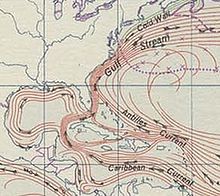Gulf Stream: Difference between revisions
No edit summary |
m rv spelling "fix" |
||
| Line 6: | Line 6: | ||
Its extension toward [[Europe]], called the [[North Atlantic drift]], makes [[Western Europe]] (and especially [[Northern Europe]]an winters) considerably warmer than they otherwise would be. For example, in January, the temperature difference between coastal [[Norway]] and northern parts of continental [[Canada]] is approximately 30 °C on average, even if they are the same [[latitude]]. |
Its extension toward [[Europe]], called the [[North Atlantic drift]], makes [[Western Europe]] (and especially [[Northern Europe]]an winters) considerably warmer than they otherwise would be. For example, in January, the temperature difference between coastal [[Norway]] and northern parts of continental [[Canada]] is approximately 30 °C on average, even if they are the same [[latitude]]. |
||
==Normal |
==Normal behaviour of the Gulf Stream== |
||
A river of sea water, called the [[Atlantic North Equatorial Current]], flows westward off the coast of northern [[Africa]]. When this current interacts with the northeastern coast of [[South America]], the current forks into two branches. One passes into the Caribbean, while a second flows north and east of the West Indies. These two branches rejoin to pour through the Straits of Florida. |
A river of sea water, called the [[Atlantic North Equatorial Current]], flows westward off the coast of northern [[Africa]]. When this current interacts with the northeastern coast of [[South America]], the current forks into two branches. One passes into the Caribbean, while a second flows north and east of the West Indies. These two branches rejoin to pour through the Straits of Florida. |
||
Revision as of 08:44, 24 October 2005


The Gulf Stream, also known as the North Atlantic Drift, is a powerful, warm, and swift Atlantic ocean current that originates in the Gulf of Mexico, exits through the Strait of Florida, and follows the eastern coastlines of the United States and Newfoundland. The Gulf Stream was the first element to be identified of the global oceanic thermohaline circulation. The Gulf Stream has a modifying influence on the climate of the east coast of North America from Florida to Newfoundland It is influential on the climate of the east coast of Florida, especially southeast Florida helping to keep temperatures warmer than in the rest of the southeastern United States in the winter. In summer the effect is opposite but small. The Gulf Stream makes the climate of offshore islands of Massachusetts, Martha's Vineyard and Nantucket, milder than than that of Massachusetts Bay, which is isolated from its effects by Cape Cod.
Its extension toward Europe, called the North Atlantic drift, makes Western Europe (and especially Northern European winters) considerably warmer than they otherwise would be. For example, in January, the temperature difference between coastal Norway and northern parts of continental Canada is approximately 30 °C on average, even if they are the same latitude.
Normal behaviour of the Gulf Stream
A river of sea water, called the Atlantic North Equatorial Current, flows westward off the coast of northern Africa. When this current interacts with the northeastern coast of South America, the current forks into two branches. One passes into the Caribbean, while a second flows north and east of the West Indies. These two branches rejoin to pour through the Straits of Florida.
Consequently, the resulting Gulf Stream is one of the strongest ocean currents known, transporting 1.4 petawatts of power. It moves at a rate of 30 million cubic meters per second. After it passes Cape Hatteras, this rate increases to 80 million cubic meters per second. The volume of the Gulf Stream dwarfs all rivers that empty into the Atlantic combined, which barely total 0.6 million cubic meters per second.
As it travels north, some of the warm water transported by the Gulf Stream evaporates. This increases the salinity of the water in the stream, and in the North Atlantic Ocean the water is so cold and dense with salt that it begins to sink. It then becomes a part of the North Atlantic Deep Water, a southgoing stream.
The Gulf Stream is one of the reasons why certain parts of the west of Britain and Ireland are an average of several degrees warmer than most other parts of those countries. Indeed, in Cornwall, and particularly the Isles of Scilly, its effects are such that plants associated with much warmer climates, such as palm trees, are able to survive the rigours of northern winters. Logan Botanic Garden in Scotland benefits strongly from the Gulf Stream, allowing their specimens of Gunnera manicata to grow to over 3 metres tall.
The effects of the Gulf Stream is also important further north. Average monthly temperatures in Røst and Værøy in Lofoten, Norway, inside the arctic circle, never drops below freezing in winter; this represents the worlds largest positive temperature anomaly relative to latitude.
Possible switching off due to global warming
References
- Corona Magazine Issue 124: Science (German, Transported amount of power)
- Hycom Consortium
